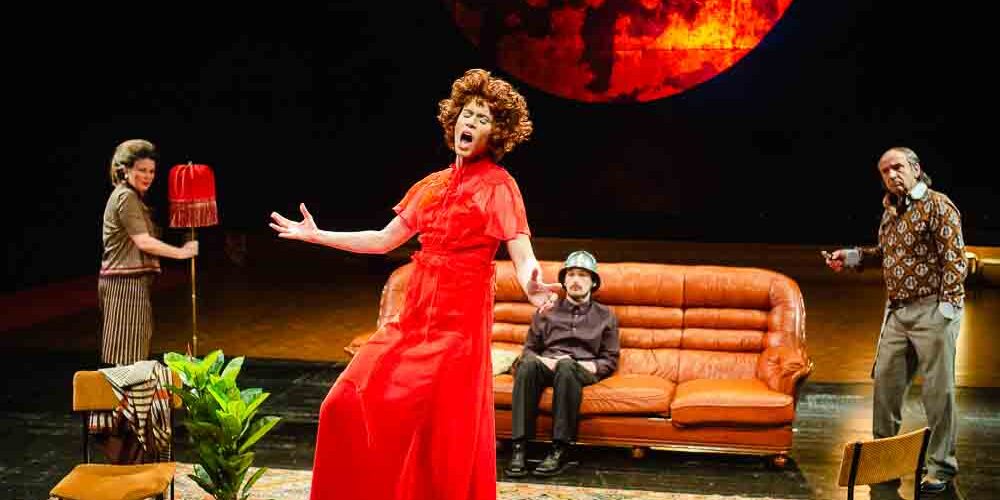Zagreb Youth Theatre, premiere 6th May 2023
‘How do you do? Would you like some tea, darling?‘ Mr and Mrs Smith are already on stage as the audience enter the theatre. Actors Nataša Dorčić and Sreten Mokrović are exchanging banal and trivial dialogue in a very artificial manner. Their conversation sounds like it comes from a recording one would use for learning English language, an allusion to the context in which Ionesco was writing his piece The Bald Soprano, first performed in 1950.
Although the play is performed in the Istra hall – ZKM’s larger stage – Suzana Nikolić’s production uses a different seating arrangement than normal. The auditorium is set on the stage itself and the scene is set in space usually used for bringing in larger pieces of scenography. The audience is seated in the shape of a square, its ‘back’ side being an iron curtain which is lifted up from the ground about a meter high, This means the spectators can only see around half of the actors’ bodies when they are moving around behind this iron curtain. What at first seems to be the main playing area, remains as a backdrop during the majority of the performance. The actual playing area is in front of the iron curtain, closer to the audience then maybe expected on first entering the space. This feeling of displacement is further enhanced by the moving of the carpet, which is so smooth, it looks at first as if it’s moved by remote control.
It’s an interesting choice to set this play in the area which is usually hidden from the sight of audience. It gives actors other possibilities to enter the stage and to move around the spectators, to hide and reappear from their gaze.
The stage design by Ana Savić Gecan is of a typical upper-middle class apartment with very 1950s style decor, with a lot of patterns and different shades of brown. The costumes too, also done by Savić Gecan, are filled with various patterns, most notably tartan and houndstooth which adds to the vintage aesthetic and evokes the time period in which the text is written. At times, a rustle from the radio can be heard, a sound which will later only add to the absurd atmosphere and the glitching of the actors’ speech and movements. These glitches and bugs become more frequent as the play moves ahead, giving the impression the characters are a part of a simulation which keeps lagging and going wrong. The idea, or rather a conspiracy theory, that we are living in a simulation, that people’s lives are programmed by a Master Computer run by something or someone is quite a popular motive in popular culture and fiction. Think Netflix’s (unfortunately) cancelled series 1899 or Herve Le Tellier’s novel The Anomaly. Sure, one can argue that theatre plays can be considered a form of simulation, even those that are seemingly based in improvisation. It’s pointless to try and differentiate what is expected and what isn’t in a performance – we might be manipulated in both cases. But, personally, this simulation aspect of the play intrigues me the most.

The Bald Soprano, ZKM
In The Bold Soprano, the scenes are interrupted by experimental music by brothers Alen and Nenad Sinkauz that also add to the glitching vibe, as does the lighting design by Aleksandar Čavlek which is sometimes so intense it’s almost blinding and it adds to the artificiality. The scenes are cut with short interludes in which the set is changed under the red light, while there’s numeric countdown that later doesn’t follow numeric order, with random numbers showing up, further signalling the chaos brewing on the stage.
Likewise, the elaborate stage movement by Šimun Stankov gives another layer to the unnaturalness. Alongside the acting, it’s the most interesting part of the performance and makes Ionesco’s piece even funnier to watch. It sometimes feels like more attention and work was put into the movement than text itself. The only problem is that, at times, the movement interferes with the speech so it can be challenging to both listen and pay attention to the actors’ motions, which are very precise and unpredictable, whether they are drinking tea from the upside-down cup or randomly holding props for no reason – ‘where is the logic?‘
The performances are all very strong, the actors all creative in the ways they embody Ionesco’s ridiculous characters. In addition to Dorčić and Mokrović as the Smiths, the part of their servant Mary is played by the energetic Hrvojka Begović, Elizabeth and Donald Martin are wonderfully portrayed by Iva Kraljević and Adrian Pezdirc – the two of them make a great comedic duo, and finally Mateo Videk plays the Fire Chief, who’s better at telling experimental fables than putting out fires it seems.
Nikolić’s production is very well executed – it’s faithful to the drama and the time period context in terms of scenography and costumes, however the actors use smart phones during the performance to take selfies and read click-bait newspaper headlines. These pieces of technology simply indicate the actuality of the text. Yet, this is the only signal from the future, the rest of the decor and props retain the 20th century aesthetic.
Nikolić’s production has a very good rhythm, too. As some parts of the text consist of repeating the same phrases, the actors have developed a good dynamic, switching the speed at which they speak their lines. When in dialogues they try and come closer to the logical answer to all of their absurd questions they ask, like Martin not realising they are married (or are they?). The before-mentioned glitches in speech and movement become more frequent and noticeble. The chaos and confusion comes out of the most banal situations, and the characters treat these occasions as part of some grand conspiracy theory to which they will never find an answer, although a simple explanation is most likely possible.
Complete chaos breaks out during Mary’s performance of her love poem to the Fire Chief, Begović performs the poem in a very expressive and dramatic manner, her tone and movement becoming more passionate and hysterical. Above her head there’s a video of fire burning (created by Marko Turčinov and Mihael Šandro) and the stage is saturated with red light, resembling an emergency light. What ensues is complete stage mayhem as the actors run around the stage speaking quickly and putting all the scenography behind the iron curtain, supposedly..
E
N
Ding!
S I M U L A T I O N…
01110011 01101001 01101101 01110101 01101100 01100001 01110100 01101001 01101111 01101110 00100000 01101111 01110110 01100101 01110010 00001010 01110011 01110100 01100001 01110010 01110100 00100000 01100001 01100111 01100001 01101001 01101110 000010104
Credits:
Author: Eugène Ionesco//Translation: Vlado Habunek, Ivan Kušan//Director: Suzana Nikolić// Scenpgraphy and costume: Ana Savić Gecan//Movement: Šimun Stankov//Sound: Alen i Nenad Sinkauz
For tickets and further information, visit: ZeKaEm.hr
Further reading: review of My Husband at Zagreb Youth Theatre
Nora Čulić Matošić (1998) is a student of Comparative Literature (MA) at the Faculty of Humanities and Social Sciences in Zagreb. She has written theatre criticism for the Croatian radio programme Theatralia and web portal Kulturpunkt.hr. Besides theatre, her interests are other forms of performing arts (particularly dance performances) and film.








